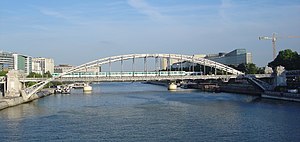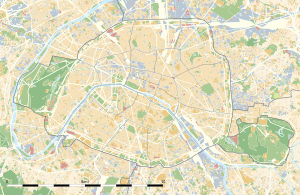Viaduc d'Austerlitz
Coordinates: 48 ° 50 ′ 37 ″ N , 2 ° 22 ′ 4 ″ E
| Viaduc d'Austerlitz | ||
|---|---|---|
| Viaduc d'Austerlitz | ||
| use | Railway bridge | |
| Convicted | Line 5 of the Paris Métro | |
| Crossing of | His | |
| place | Paris , France | |
| construction | Arch bridge | |
| overall length | 140 meters | |
| start of building | 1903 | |
| completion | 1904 | |
| location | ||
|
|
||
The Viaduc d'Austerlitz is a bridge on line 5 of the Paris Métro over the Seine .
history
On June 2, 1906, line 5 of the Paris Métro was opened from the Place d'Italie station to the Gare d'Orléans (today: Gare d'Austerlitz ) on the left bank of the Seine. The bridge over the river was built between November 1903 and December 1904 by the Société de Construction de Levallois-Perret . On July 14, 1906, the extension of line 5 to the Place Manzas station on the right of the Seine (since 1916: Quai de la Rapée ) went into operation.
Construction and location
The Viaduc d'Austerlitz is a steel arch bridge with a clear width of 140 m, it exceeded the Pont Alexandre III, completed in 1900, by 32.50 m. In order not to hinder shipping traffic - due to the nearby ports of Port de l'Arsenal and Port de la Rapée as well as the warehouses of Bercy - river piers were not used. The engineer responsible for the construction was Louis Biette . The designs for the decorations come from Jean Camille Formigé , the sculptures were made by the sculptor Gustave Michel . In addition to fish, maritime symbols such as anchors, oars and trident are also used.
The two parabolic arches are 31 m high. They are designed as three-hinged arches and have joints at the highest point and on both sides near the bank. The bridge deck, 11 m above water level, is held in the central section by sixteen vertical hangers. Crossing diagonal struts serve to stabilize in the transverse direction. The abutments rest on masonry plinths 22 m long and 18 m wide, and the pylons (two each) are 15 m high. The bridge is 8.50 m wide between the railings. The tracks are laid without ballast.
A wooden frame with several pillars was erected for the construction of the bridge. First the bridge deck and then the arches were built on top. The scaffolding was dismantled in mid-1905. In 1936, the bridge was reinforced to enable the passage of heavier metro trains. In the course of repair work, rail traffic was interrupted in July and August 2013.
In June 1986 the building was placed under monument protection and declared a monument historique . Since January 18, 2000, it has been illuminated at night when the Métro is operating.

In the area of the Gare d'Austerlitz station to the left of the Seine , Métrolinie 5 is an elevated railway at the same level as the Viaduc d'Austerlitz.
The Viaduc du Quai de la Rapée joins on the right bank of the river . On this the route leads in a tight curve of about 90 degrees and a radius of 75 m under the access to the downstream road bridge Pont d'Austerlitz through to the station Quai de la Rapée located at ground level. The Viaduc du Quai de la Rapée was built in 1903 by Daydé & Pillé , it has a continuously curved floor plan instead of the polygonal structures made up of straight components that were common up to that time . It is composed of two yokes that are 40.35 m and 34.05 m long. With a gradient of 40 ‰, it is considered the most difficult section in the metro network.
Trivia
In Jacques Tardi's crime comic Brouillard au pont de Tolbiac (German: The Bridge in the Fog) based on a novel by Léo Malet , an opponent of the main character Nestor Burma is run over by a Sprague-Thomson metro train on the Viaduc d'Austerlitz .
Web links
Individual evidence
- ↑ a b Viaduc d'Austerlitz. In: Mérimée database . French Ministry of Culture , accessed 26 September 2013 (French).
- ↑ a b c d Jean Tricoire: Un siècle de métro en 14 lignes. De Bienvenüe à Météor . La Vie du Rail, Paris 2004, ISBN 2-902808-87-9 , p. 194
- ^ Julian Pepinster: Le métro de Paris . Éditions La Vie du Rail, Paris 2010, ISBN 978-2-918758-12-9 , p. 17 .
- ^ Clive Lamming: Métro insolite . 2nd Edition. Éditions Parigramme, Paris 2001, ISBN 2-84096-190-3 , pp. 108 .
- ^ Léo Malet, Jacques Tardi: Brouillard au pont de Tolbiac . Étitions J'ai lu, 1987, p. 190 .


